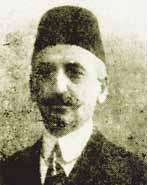Temko Popov
Temko Popov (Serbian Cyrillic: Темко Попов) was a pro-Macedonian activist and Serbian national worker in the Ottoman Empire.
Temko Popov | |
|---|---|
 | |
| Born | Темистокли Темко Попов 1855 |
| Died | 1929 Ohrid, Kingdom of Serbs, Croats and Slovenes |
| Nationality | Ottoman, Macedonian |
| Other names | Temko Popović (Темко Поповић) |
| Organization | |
| Known for | being Macedonian national activist and an activist of the Serbian national movement in Macedonia |
Life
Popov was born in Ohrid, then in the Ottoman Empire. He graduated from high school in Athens, Greece. In Athens he worked in various Orthodox agencies. Then Temko worked as a teacher in Edirne and afterwards in the Bulgarian Men's High School of Bitola. Subsequently, he moved to Sofia, Bulgaria, where he was among the founders of the secret Macedonian Society established in 1886 to promote a Macedonian identity, distinguished especially from the ethnic identity of the Bulgarians.[1] The other leaders were Naum Evrov, Kosta Grupčev and Vasilij Karajovev.[2]
Chased by the Bulgarian authorities in late August 1886, they moved to Belgrade, where they led negotiations with the Serbian government on the Macedonian issue, and participated in the formation of the Association of Serbo-Macedonians the same year. At that time “Macedonism” was seen by the Serbian government as a possible counterweight to Bulgarian influence in Macedonia and as a stage to the gradual Serbianisation of the Macedonian Slavs.[3] From Belgrade, he was sent by the Serbian authorities in Thessaloniki, where he was infiltrated to work into the Bulgarian high school. However, in 1887 he was expelled from there because of his pro-Serbian propaganda. In 1888 in a letter to Despot Badžović, Temko Popov emphasized the most important aim: to Macedonize the Macedonian Slavs.[4] In the same latter he stated:
"Let us no lie to ourselves, Despot, the national spirit in Macedonia has reached such a stage today that even if Jesus Christ had come to the Earth, he would not have been able to persuade the Macedonian that he was a Bulgarian or a Serb, excepting those Macedonians in whom Bulgarian propaganda has already taken root".
This activities of Popov had been criticized by the Bulgarian intelligentsia in Macedonia. On this occasion, Kuzman Shapkarev wrote in a letter to Marin Drinov in 1888 that "One freak - Temko Popov, illegitimate son of Stefan Vladikov - the traitor of Dimitar Miladinov, lies to the Serbian consul in Tsarigrad (Stojan Novaković),[5] that he would turn the Macedonian Bulgarians into Old Serbs".[6] Temko moved back to Belgrade where the Saint Sava society helped him materially to his new assignment at work. This compromise with the Serbian interests led him later to abandonment of his separatist program altogether.[7] Subsequently, from 1888 to 1913 Temko was on Serbian diplomatic service consistently in Thessaloniki, Istanbul and Athens. As result since the eve of the new century, he and his collaborators promoted only pro-Serbian ideas.[8] After the Young Turk Revolution, Temko became a Serbian deputy to the Ottoman parliament in 1908–09, when he lived in Constantinople. Later he worked in the Serbian Embassy in Athens until the end of the Balkan Wars in 1913. Then he moved to Ohrid, just ceded to Serbia, and became its mayor until the Bulgarian occupation in 1915. In 1918 after World War I he served as the mayor of Ohrid for second time. In 1921 Popović was appointed inspector in Agricultural service in Bitola, where he retired.
References
- Roumen Daskalov and Tchavdar Marinov. Entangled Histories of the Balkans: Volume One: National Ideologies and Language Policies. BRILL, 2013. p. 316
- Dragan Taškovski (1969). Rađanje makedonske nacije. Zavod za izdavanje udžbenika Socijalističke Republike Srbije. p. 175. Retrieved 23 May 2013.
коју су предводили Наум Евров, Коста Групчев, Василиј Карајовев и Темко Попов
- Contested Ethnic Identity: The Case of Macedonian Immigrants in Toronto, 1900-1996, Chris Kostov, Peter Lang, 2010, ISBN 3034301960, p. 65
- Jovan Pavlovski; Mišel Pavlovski (1993). Od prvična ideja do država: eden možen pogled na razvojot na nacionalnata misla i državnosta kaj Makedoncite. Detska radost. p. 45. Retrieved 25 May 2013.
да не се лажеме, Деспоте, националниот у Македонија до такво дередже денеска је стигнал, што то и сам Исус Христос ако слезит од небоно не можит да го уверит Македонеца оти тој е блгарин или србин, освен оние Македонци у кои веќе пропагандата блгарска се има вкоренено
- According to Novaković the Bulgarian idea was deeply rooted in Macedonia and it was almost impossible to shake it completely by opposing it merely with the Serbian idea. That was why the Serbian idea would need an ally that could stand in direct opposition to Bulgarianism and would contain in itself the elements which could attract the people and their feelings and thus sever them from Bulgarianism. This ally he saw in Macedonism. Novaković's diplomatic activity in Constantinople and St. Petersburg played significant role for the realization of his macedonist ideas. The diplomatic convention with Ottoman Turkey signed in 1886, due to Novaković's skillful negotiations, made possible the opening of Serbian consulates in Skopje and Thessaloniki. He was instrumental in organizing a huge network of Serbian consulates, secular and religious Serbian schools and Serb religious institutions throughout Turkey in Europe, in particular in Macedonia, where he aided macedonist intellectuals. Angel G. Angelov, The European Legacy: Toward New Paradigms, 1470-1316, Volume 2, Issue 3, 1997, pp. 411–417
- Makedonizmŭt i sŭprotivata na Makedonia sreshtu nego, Kosta Tsŭrnushanov, Universitetsko izdatelstvo "Sv. Kliment Okhridski,", 1992, str. 38.
- Sociolinguistica, Volumes 5–6, Klaus J. Mattheier, Publisher: M. Niemeyer, 1991, ISBN 3484603682, p. 131
- Historical Dictionary of the Republic of Macedonia, Dimitar Bechev, Scarecrow Press, 2009, ISBN 0810855658, p. 162
Sources
- Društvo Sv. Save (1936). Spomenica Društva Svetoga Save, 1886-1936. Društvo Sv. Save.CS1 maint: ref=harv (link)
- Биљана Вучетић (1 September 2012). Наша ствар у Османском царству: Our Issue in the Ottoman Empire. Istorijski institut. pp. 63, 107. ISBN 978-86-7743-095-5.